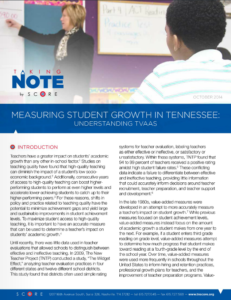As a former classroom teacher and current education policy student at Vanderbilt, I am interested in measuring teaching quality to develop instruction and improve student learning in classrooms. Teachers have a greater impact on student learning than any other in-school factor. For this reason, it is critical to ensure quality teaching in every classroom.
In Tennessee, the Tennessee Value Added Assessment System (TVAAS) is one measure schools and districts use to assess teaching quality. SCORE has released a memo on TVAAS that explains how TVAAS was developed, provides insight into its calculation, and shares ideas on how it can be used alongside other measures to inform decisions to improve student learning. Here are three of the major points addressed in the memo.
SCORE’s memo provides an overview of previous teacher evaluation systems, which laid the foundation for the development and use of measures like TVAAS. Until recently, there was little data available that schools and districts could use to differentiate between effective and ineffective teaching. Previous teacher evaluation systems generally consisted of short and infrequent observations that resulted in general ratings of “satisfactory” or “unsatisfactory.” These teacher evaluation systems generated satisfactory ratings for nearly 99 percent of teachers, while student achievement scores remained low.
Seeking to address an incomplete system of measuring teaching quality, researchers from the University of Tennessee-Knoxville developed TVAAS to measure a teacher’s impact on student learning. TVAAS estimates student academic growth based on previous student achievement scores on standardized assessments. For example, if a student enters fifth grade performing on grade level in math, TVAAS attempts to measure the progress that student makes toward performing at a 6th grade level in math by the end of the school year. Teachers’ TVAAS scores are determined by comparing students’ predicted growth to their actual growth over the course of the school year.
The Value of TVAAS
The TVAAS memo outlines different ways TVAAS can be used by teachers, school leaders, district leaders, and policymakers to promote student learning. One example included in the memo is about how teachers can use TVAAS to inform decisions about what types of professional learning opportunities they want to pursue. For instance, TVAAS allows teachers to see how their instruction impacts students from different racial groups, exceptional learners, and students in English and math. This data, when combined with data from other measures such as classroom observations, can influence what professional learning opportunities teachers pursue. If a teacher has a high TVAAS score in reading, but a lower TVAAS score in math, they might pursue professional learning opportunities in math to improve their instruction in that subject.
TVAAS and Standardized Assessments
SCORE’s TVAAS memo also outlines what opportunities there are for Tennessee to improve TVAAS measures. One of these opportunities for improvement centers on the need for high-quality, aligned assessments in Tennessee. The TVAAS system operates under the assumption that the state’s standardized assessments are reflective of student learning. Considerable research, however, demonstrates that many state tests are not well aligned with the academic standards taught in classrooms. As Tennessee implements new standards in English language arts and math, it is important for the state’s standardized assessments to align with these standards. In order for TVAAS scores to be a helpful component of a broader evaluation system, Tennessee’s assessments must be an accurate measure of students’ progress on the standards implemented in classrooms
SCORE concludes that while no measure is perfect on its own, using TVAAS data in combination with student surveys, teacher observation data, and student achievement scores provides a more comprehensive measure of teaching quality than was previously available. By employing multiple measures of teaching effectiveness, teachers, school and district leaders, and policymakers can make more informed, data-driven decisions that increase student access to high quality learning opportunities in classrooms across Tennessee.
Read Measuring Student Growth in Tennessee: Understanding TVAAS.

